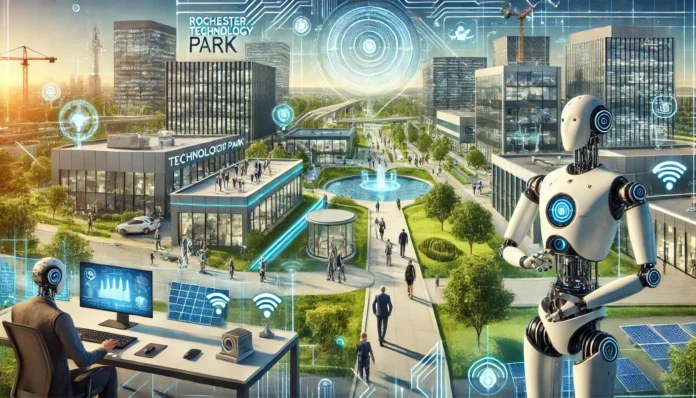Future Drives
Technology drive, or technological drive, refers to the rapid development and adoption of innovations that fuel progress across various industries. From artificial intelligence to renewable energy, technology drives the transformation of businesses, societies, and everyday life. This article delves into the effects, pros and cons, comparisons, market values, and more, while integrating terms like “4005 Technology Drive,” “technology park drive,” and “Rochester Technology Park.”
Effects of Technology Drive
Positive Effects
- Enhanced Productivity: Technological advancements streamline workflows, enabling businesses to accomplish more in less time.
- Improved Quality of Life: From healthcare innovations to smart home devices, technology has significantly improved living standards.
- Global Connectivity: The internet and mobile technologies have bridged distances, allowing instant communication and access to information.
- Economic Growth: Technology drives economic expansion by creating new markets, job opportunities, and industries.
Negative Effects
- Job Displacement: Automation and artificial intelligence can replace human workers, leading to unemployment in certain sectors.
- Cybersecurity Risks: The increasing reliance on technology makes businesses and individuals vulnerable to cyberattacks.
- Environmental Impact: Manufacturing and disposing of tech products contribute to e-waste and carbon emissions.
- Digital Divide: Not everyone has equal access to technological advancements, widening socio-economic gaps.
Pros and Cons of Technology Drive
Pros
- Efficiency: Automation reduces human error and increases operational efficiency.
- Innovation: Technology fosters creativity and the development of groundbreaking solutions.
- Scalability: Businesses can expand operations with minimal additional resources thanks to cloud computing and digital platforms.
- Accessibility: Online learning and telemedicine have made education and healthcare more accessible.
Cons
- Cost: High initial investment is often required for adopting new technologies.
- Dependency: Over-reliance on technology can make businesses vulnerable to system failures.
- Privacy Concerns: The collection and use of personal data raise ethical and legal issues.
- Obsolescence: Rapid technological advancements render older systems and skills obsolete.
Comparisons and Similarities
Technology Drive vs. Technological Drive
Both terms are interchangeable and signify the push towards innovation and modernization. However, “technological drive” often emphasizes the engineering and scientific aspects.
Differences Between 4005 Technology Drive and Rochester Technology Park
- 4005 Technology Drive: Often a specific address associated with a business hub or office location.
- Rochester Technology Park: A larger industrial and commercial park designed to house multiple tech-driven companies, offering infrastructure and resources to support innovation.
Similarities Between Technology Park Drive and Rochester Technology Park
Both locations are hubs for technological innovation, fostering collaboration among companies and providing shared resources to drive growth.
Market Values and Worth
The global technology market is one of the most lucrative sectors. Below is an estimation of market values:
| Technology Sector | Market Value (2024, Estimated) | Growth Rate (CAGR) |
|---|---|---|
| Artificial Intelligence | $200 billion | 35% |
| Cloud Computing | $830 billion | 17% |
| Renewable Energy Tech | $1.2 trillion | 8% |
| Internet of Things (IoT) | $1 trillion | 26% |
The worth of individual technology parks varies based on location, size, and tenants. For instance, the Rochester Technology Park has an estimated property value in the hundreds of millions, making it a key asset in the regional economy.
Costs and Expenses
Adopting technology often involves significant upfront costs. Below is a breakdown of potential expenses:
| Expense Category | Average Cost (Estimated) |
| Software Development | $10,000 – $500,000+ per project |
| Hardware Infrastructure | $5,000 – $1,000,000+ |
| Employee Training | $1,000 – $10,000 per employee |
| Cybersecurity Solutions | $5,000 – $50,000 annually |
Organizations in technology parks, such as those on Technology Park Drive or Rochester Technology Park, often share resources like high-speed internet and specialized facilities, reducing individual costs.
Companions of Technology Drive
Key Players
- Tech Giants: Companies like Google, Microsoft, and Amazon are at the forefront of technological advancements.
- Startups: Innovative startups drive niche markets, creating disruptive solutions.
- Academic Institutions: Universities and research centers contribute through R&D and talent development.
Infrastructure
- Technology Parks: Locations like Rochester Technology Park provide essential infrastructure for businesses.
- Incubators and Accelerators: These entities support startups with funding, mentorship, and networking opportunities.
FAQs
What is 4005 Technology Drive?
It is often associated with a specific business location or tech hub, serving as an address for companies focused on innovation.
What is the significance of Rochester Technology Park?
Rochester Technology Park is a key industrial and commercial hub, housing various tech companies and contributing to regional economic growth.
How does technology drive economic growth?
By creating new industries, enhancing productivity, and fostering innovation, technology drives economic expansion.
What are the costs associated with adopting new technology?
Costs include software development, hardware infrastructure, employee training, and cybersecurity, which can range from thousands to millions of dollars depending on the scope.
How do technology parks support businesses?
They offer shared resources, state-of-the-art facilities, and a collaborative environment to help companies thrive.
In conclusion, the technological drive is a double-edged sword with immense potential to shape the future. Understanding its effects, costs, and opportunities is essential for businesses and individuals to harness its benefits while mitigating challenges.
